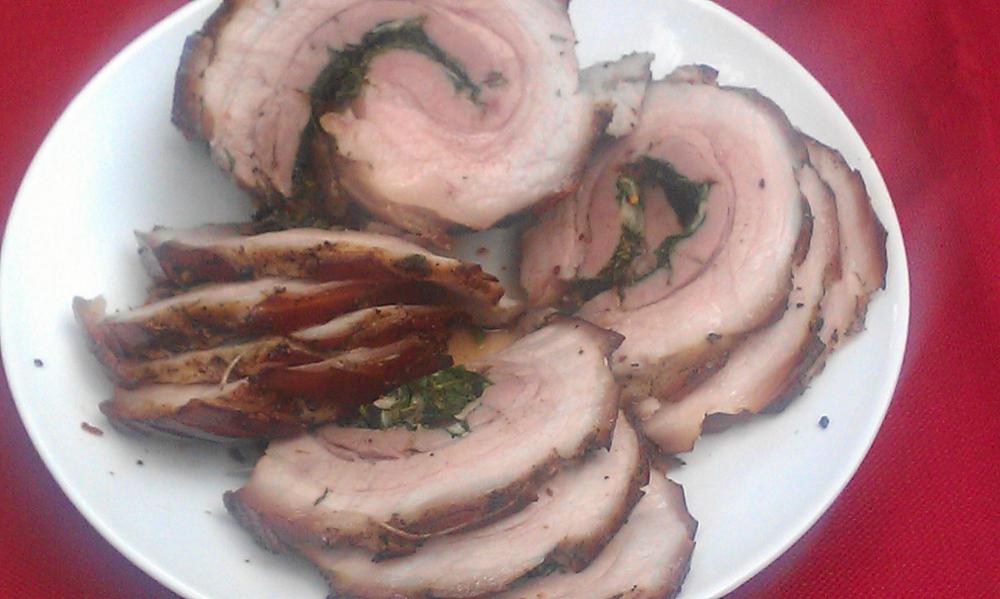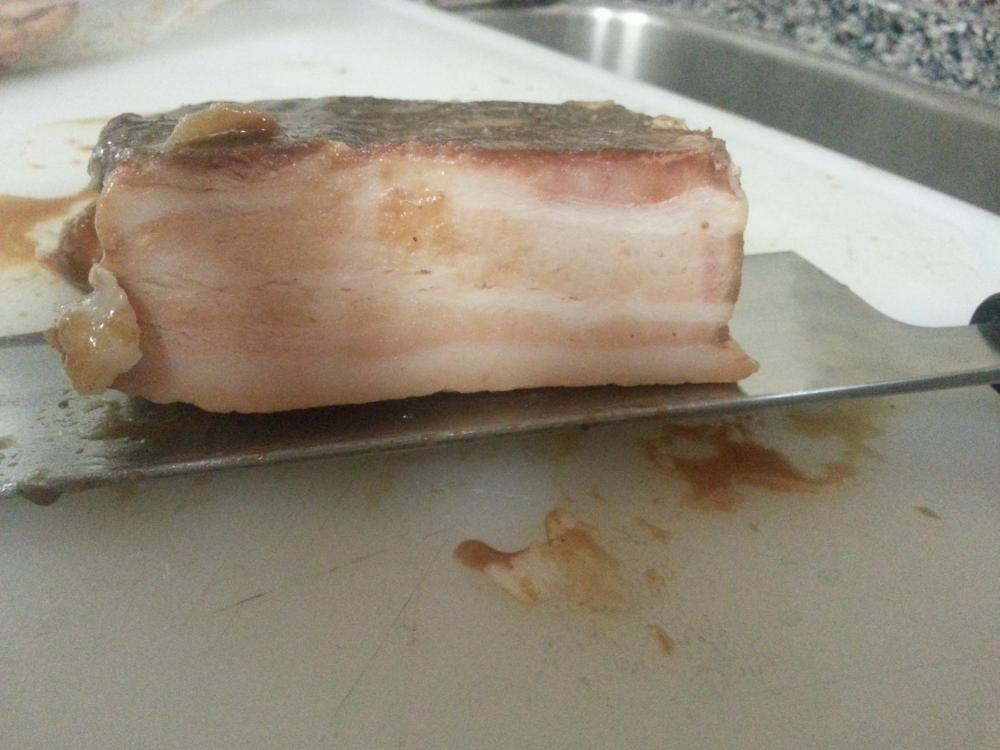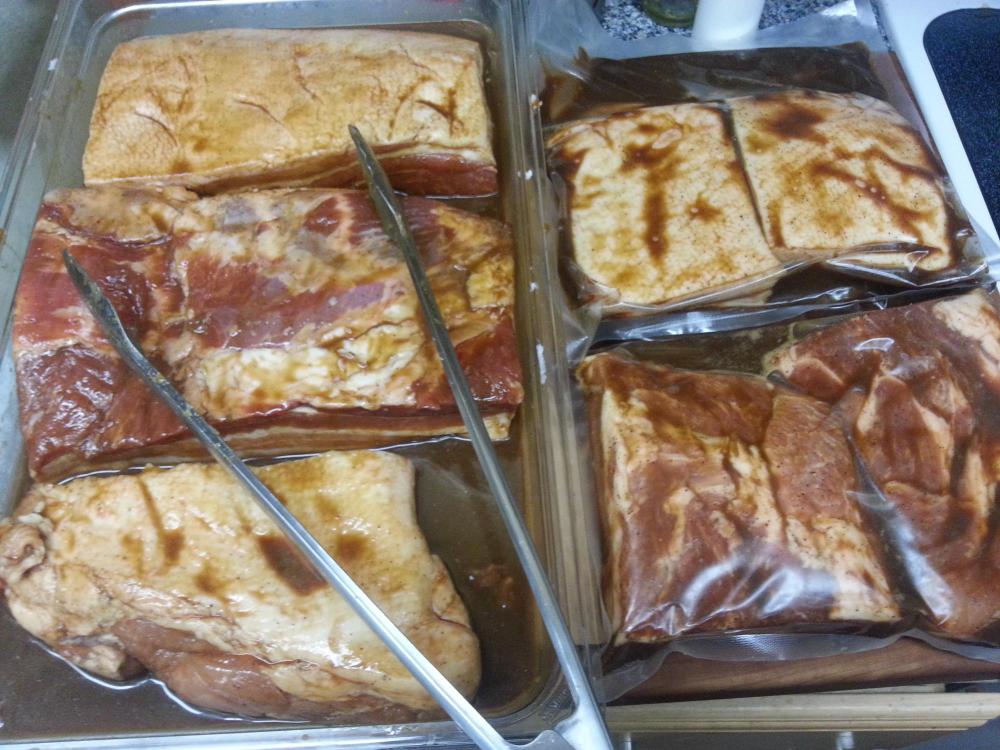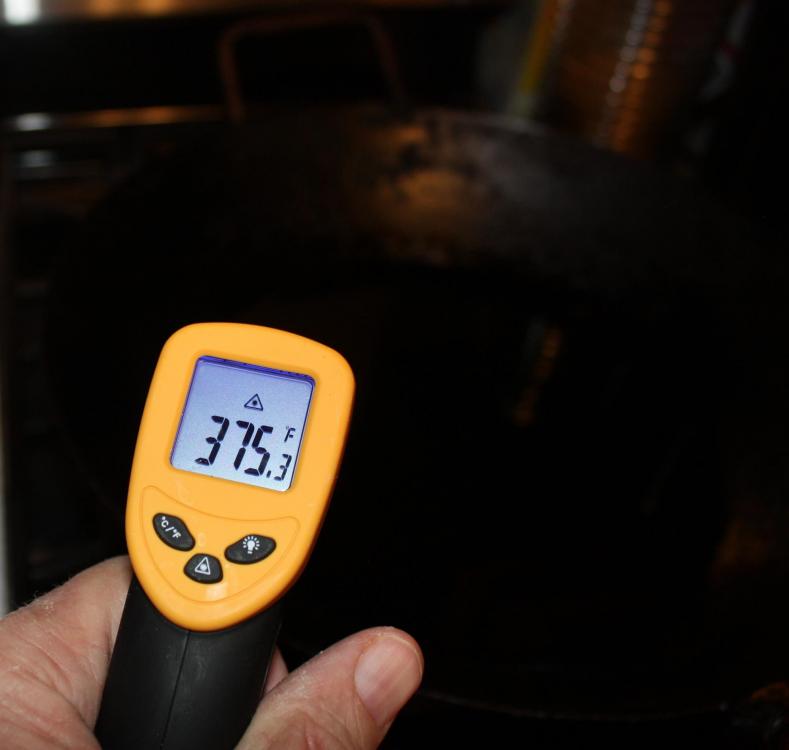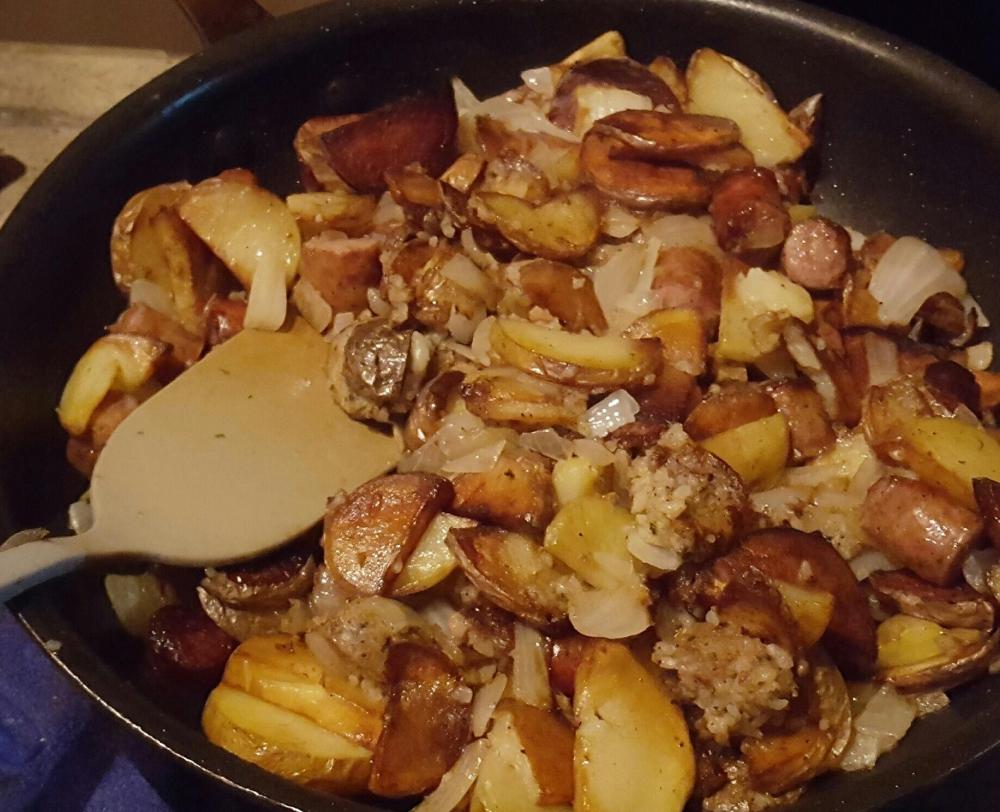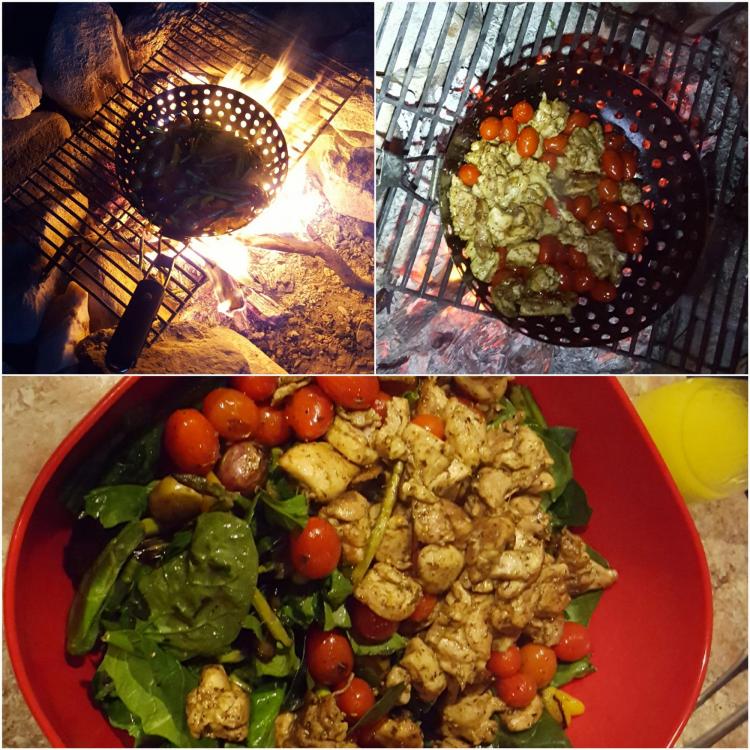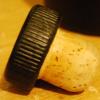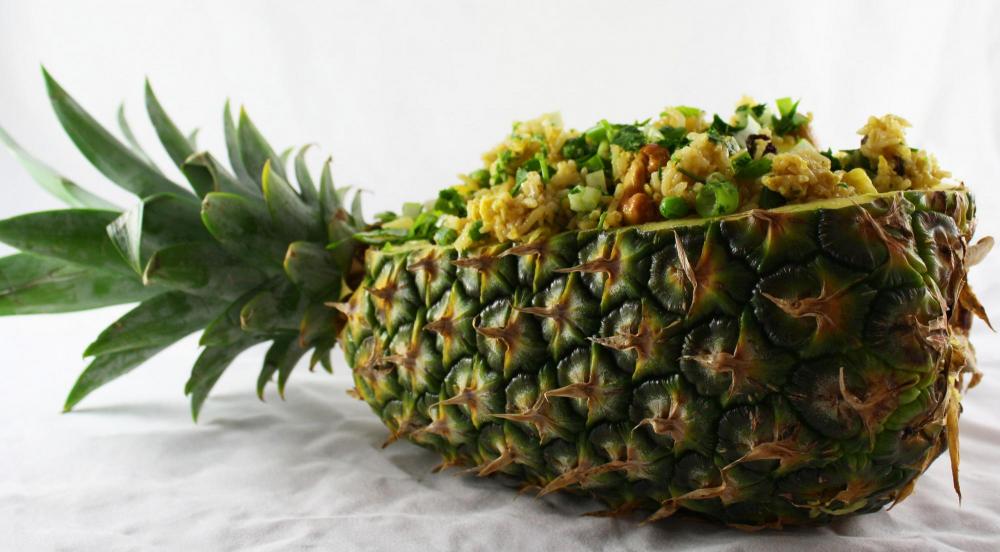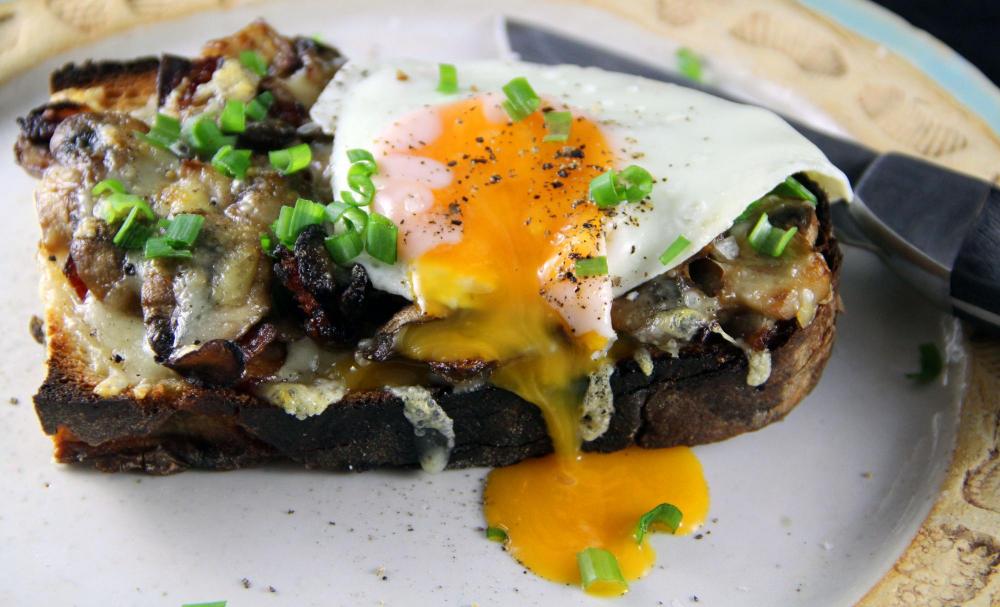Search the Community
Showing results for 'wok'.
Found 5,159 results
-
Ive succumbed and gotten the DARTO # 27. I had to call them to give them my MC number, as Im very allergic to PayPal. they were very nice. I spoke with Nicolas and sent him the eG threads on the DARTO pans. he has enjoyed them. I( decided the # 27 , with the flat bottom and heavy steel will suit me as a sort of Wok ! ( what ever excuse one needs , eh ? )
-
Amazon has the Flaxseed oil, several variants of it. I use it in the oven, light application, wipe, into hot oven for an hour, turn oven off, let cool. Repeat. Have done same on stove top and outside on the wok burner. In "Breath of a Wok" Young talks of final seasoning of a wok with Chinese onions or spring onions for luck. I need all the luck I can get in the kitchen so my last seasoning session I'll saute a qt or so of onions until carmalized. No defensible reason just my thing. The only time I've had flake offs was when I tried to shortcut the process and use to much oil at once. Don't do that anymore.
-
I don't know where they got their figures for flaxseed oil but that polyunsaturated percentage is really high, considering there is only 19% Oleic acid. Rice bran oil, which I have been using in recent years because of the high smoke point, has 38% Oleic acid, and that component is an important "drying factor" that promotes polymerization with heat. When a friend got one of the high output burners and a new wok last year, the vendor recommended he use rice bran oil and even gave him a small bottle to begin seasoning the wok. It's not cheat put I have found a little goes a long way. I use it in my baking a lot - in yeast breads where I want a fine, even crumb and this oil contributes to the quality I want.
-
Looks like you're off to good start. I'm not a fan of zip locks for a long cook, but if that's what you have to work with then..... 2nd the part about clipping the edge to the top of the container so that the seal is not submerged. Your container should be fine with a circulator though I would prefer a 12 qt Cambro for most SV. For long cooks I like a Coleman "stackable". For either container (or yours) a 2 1/2" hole saw will cut an opening for the Anova bluetooth unit. (2 3/4" for Anova 1) If you still have concerns about doing it as a roll you can steak it and do it as pieces (my preferred method) or whole but not rolled per David Chang. The belly pictured was done at 140F. (Pork likes 140F) It was seared outside in a wok. Your oven, cranked up and on broil will work fine but will take it out of commission for dinner rolls, warming, finishing sides etc. Super hot grill, esp with cast iron skillet will work well. Don't forget the liquids in the bag make a great addition to sauce. SV Porchetta stuffed with chick food. Duroc belly steaked: (Note: When steaked you can do as much or as little of the belly as you would like, Freeze other pieces for another day.
-
Fresh Point Judith Squid, I like to clean and prep them myself, not just because it is $2.99 per lb vs $8.99 per, but because I cleaned it myself and know the product much better as a result. To me, these are prime size, being just about a foot long on average. Once you get the moves down, cleaning is a piece of cake. Once cleaned, cutting them up is pretty simple. I cut the "tubes" into 3/4" rings. I shake them up in a plastic bag with about a half cup of flour, seasoned with salt, garlic powder and smoked paprika. I used to use clip on thermometers, but they were awkward and always got in the way. When, you have a big pot of flammable oil over a gas flame, ( I use a wok) simple is best. I love the infra-red hand held thermometer, simple, quick and now, inexpensive. Get the peanut oil up to 375 F. I Fry them up in small batches, so the temp only drops to about 350 F, then drain on paper towels, season with a sprinkle of salt and keep them in a warm oven as the later batches are completed. Tonight, I served the calamari with salads and spicy garlic and lemon aioli. HC
- 636 replies
-
- 24
-

-
We've been out in the desert for a couple of weeks, finally in an area where we can have campfires when it isn't too windy. We've had a few wind storms (it's blowing again right now, but supposed to grow quieter this evening) but also some beautiful weather. There's an art to building a fire ring suitable for cooking something more than hot dogs on sticks, and my darling is pretty good at it. The main tricks are to build the ring with an opening so wood can be added after the grate is down, to have the grate support at the right height above the fire, and to have a level top so the grate can be level. I've seen manufactured rings that allow the grate height to be adjustable. We aren't quite that enterprising; we simply adjust the fuel instead. One of his favorites is hash: potatoes, onions, and some sort of sausage. I think this particular sausage was a leftover from Louisiana. (Yes, we still have some!) I prefer fireside salads, when possible. This one had potatoes, peppers, tomatoes, asparagus and seasoned chicken, all cooked in a grill wok then tossed over fresh spinach. A lemon and garlic vinaigrette completed the ensemble. There's a story behind the new salad servers. I'll tell it in another post.
-
Sounds like a typical asian cookbook (for the locals)! Chilli powder wouldn't be specific - so get one of an appropriate heat level for your tastes. Nyonya cooking likes it HOT! If it isn't hot, then its bland as my Singaporean friend kept reminding me that night at our local Nyonya restaurant. Streak pork = pork belly - ie the meat has streaks of fat through it. Deep frying, the wok method, is very popular. Although, having to wait for the oil to cool down and then poor back into a bottle once cold is a pain. A western deep fryer would be simpler in my books - throw a lid on it and store. I think washing the spices comes down to quality - this day and age I think we're fine. You heat the spices individually before grinding to release the aromas. I normally heat on the stove with a dry frying pan on medium, when the aroma hits you you're done. Careful not to burn the spices, so stir frequently.
-
Specific to your black flake problem, it could be that the extra seasoning that you tried didn't adhere properly to the factory seasoning. The few factory finished pieces I have bought over the years, I have ended up stripping and then reseasoning to my process. Different fats will work but you should be aware of their smoke points, and they don't all give same results as far as how durable they are. I prefer using a high smoke point oil, refined grapeseed is usually what I have in house. Many thin coats with long enough between applications to fully polymerize. a CS wok I bought a couple years ago with about 10 or 11 very thin layers
-
There's a recipe that's done in a wok. I've seen that doing the rounds here. It's maybe the least time-consuming variation I've seen. I liked the method in the recently-released All Under Heaven, though. The book itself is a worthy addition to most anyone's collection, and the pork appealed to adult and child alike. I served leftovers in a sandwich, just as I would with any kind of roast or barbecued meat. It's not like the flavour profile is too far removed from barbecue.
-
The more I study this book, I realize that I don't really know who its intended reader is... The dishes seem to be a "greatest hits" of Peranakan dishes - many of which I saw when I was at the Peranakan restaurant on my last trip to SG - check out my blog for photos, etc... but some ingredients and technique descriptions are so vague.... I find it interesting that the author does not list the amount of coconut milk used in various recipes - but instead, has the cook make their own coconut milk for each dish! So, instead of using 300ml of coconut milk (for example), the author would have you grate 700g of fresh coconut and squeeze to get the coconut milk (she calls #1 Coconut milk, which I imagine is actually coconut cream). She'll then have you add water to the grated coconut to make #2 coconut milk (what I guess is coconut milk). But, I think the book assumes that the reader already has an intimate knowledge of the cooking techniques associated with this cuisine. In addition to the chilli/curry powder issues I described above, it uses such vagaries as: -an ingredient called Streaky Pork (not defined anywhere) -giving directions for deep frying a certain dish, she says "In a heated wok, add cooking oil and heat until very hot" -after marinating chicken, "Place chicken in the sun to dry thoroughly" -for Satay, the main ingredient is just "Pork" - with no specification as to the cut -instructions for making a curry powder for meat: "Wash [whole spices] separately, drain well, and dry in the sun".... put the ingredients on a tray, "Heat oven slightly" and toast the tray of [spices]..... what is the temperature equivalent of "heat oven slightly"? Maddening.... I really want to like this book, and use it, but I wish I could ask questions of someone to help out with the stuff that is vague.
-
Yes, there's a wok smoking tutorial over on Serious Eats - Wok Skills 101: Indoor Smoking that may be helpful if someone wants to use a wok. The recipe calls for blanching the corn first, then smoking 15 minutes over apple, cherry or peach wood. I ordered Cameron brand apple wood smoker chips from Amazon. I did my usual microwave in the husk method, peeled off the husks and followed the 15 min smoking time. You can see from the picture I posted upthread that the corn I smoked this way is much lighter than the photo in @Steve Irby's post just above but I thought the amount of smoky flavor it imparted was good.
-
Thanks for the Saveur link. I'd seen this technique (and done something similar in a wok, for tea-smoked duck) but forgotten about it. It'll be the ticket for me for the next few months. What kind of wood did you use, and how long did you smoke the corn?
-
Smoke signal... (from an old wok I use for smoking stuff). For smoking I used some aromatic wood chips, Sichuan peppercorns and Orange Pekoe tea. Rosemary between the breasts. First smoked then finished in the oven. Intensely smokey and still nicely pink in the middle. Kind of hard to test the doneness when both sides are fatty skin which plumps up during cooking. Because autumn...
- 499 replies
-
- 18
-

-
Rustwood. Unequivocally I would still go with induction. The pan restrictions are really not a problem. I use a lot of le Creuset pots and pans and they are fine and, as I mentioned, as far as I can see gas doesn't really have any advantage over induction for woks. Electric ovens are actually preferred to gas by most cooks, although I would suggest getting a double oven, it makes life a lot easier. I also found that having a lot of lazy susan shelves is a great idea (my kitchen came with six large corner ones and they are great). Don't get any Whirlpool products, I replaced a Bosch double oven with a Whirlpool last year and I have had nothing but problems culminating with a refusal by Whirlpool to honor their warranty. Miele is the best from what I hear but expensive and they no longer make a 27 inch (I have cherry cabinetry that I love and don't want to replace) I had a Jennair electric cooktop that was not much good and the induction tops are much more responsive. I also haven't found any problem with controlling the level. The speed of response, which is a major problem with electric tops, is as fast as gas and cools off much much faster. Induction is also much safer, I had a colleague whose wife was killed when their gas cooker exploded It is also much easier to clean than gas or electric because spills and stains don't burn into the surface since only the area under the pan is hot. Oh and it heats up the kitchen much less. Lastly, I find it much easier to work around the cooktop when it is induction, you don't have to worry about burning yourself and you can use the rest of the cooktop to cut and serve. I would argue for a five burner top though. It isn't so much that you need all five burners but it allows you to spread three or four pans around more.
-
@IANSTUART, clearly you are happy with induction, but if you were redoing your kitchen and had the choice, would you do induction again or go with gas? We are going to be redoing our all-electric kitchen (came with the house) and have been planning on running gas to it (we have natural gas heat). I was surprised to find that electric seems to be the way to go for ovens these days and now there is a lot of induction buzz so I am reconsidering the gas line. Neither the pan restrictions nor the wok issue is a deal killer for us. We currently have a 220V Bosch electric/glass cooktop that was once a high-end model. It has one high-power/instant element, but we aren't thrilled with the level of control it offers on any of the elements. Even after many years of using it, finding the right medium or medium-low setting always seems involve more trial and error than it should, certainly more so than the gas elements in our previous home. I'd be interested to hear if anyone has that issue with their induction hobs.
-
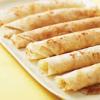
Induction? Pro-style gas? Please help!!!
Thanks for the Crepes replied to a topic in Kitchen Consumer
Hi teapot, Thanks for starting this very interesting discussion. I'm no scientist, but the answer to your question I quoted is absolutely not. If a warped flat bottomed pan is a problem, don't you think the tiny contact area of a round wok would? I know your question was born of wishful/magical thinking, but it sure would be nice, wouldn't it? I love a round wok too, but I have learned to work around it with a conventional electric stove and a very heavy KitchenAid stainless tri-ply bottom skillet that is oversized with high rounded sides. I bought it when I was younger, and the weight is beginning to be a challenge, but I still pull it out for stir fries. I also love the ideas that have been brought up about the portable wok burners that are available in my Pan Asian market. There are so many good ideas here, including the super output outdoor propane wok burners. When there is a will to cook, one will find a way. -
Love those Dehillerin copper pans and it's a pity you can't use them. I've seen induction pan converters advertised...would those work for you? Thanks for sharing your thoughts about induction -- it will help shape my questions when I go to test drive various options next week. A question regarding the wok. Do you think it would be possible to use a round bottom wok on the cooktop if it was surrounded by towel roll or something to hold it in place? And if so, could you use a power boost to create the kind of heat you'd want?
-
When I moved from downtown DC to the Maryland countryside fifteen years ago I had to given up gas. I looked into propane (I wanted a La Cornue range) but settled for electric. A disaster. However, after using induction cooktops in Europe (they have been popular for decades there) I became a convert and have used a five burner induction cooktop for the past ten years (supplemented by two more individual hobs). You CAN bridge two elements to use a large pan (I have a couple of large le Creuset dutch ovens that I use that way). You don't miss exact control (with eighteen levels I don't really think that you can get more exact control with gas). You reduce the risk of injury dramatically and have much more work space because you can use the rest of the cooktop while you are using some of the burners (since it doesn't heat up). Cleanup is MUCH MUCH easier because even the "burners" don't get really hot; cleaning an electrical or gas top is a real pain. You may not even need a hood because there simply induction works directly on the pans. There is absolutely no shortage of induction capable pans; I can't use my Dehillerin copper pans that I got while I was doing a course at La Varenne thirty years ago but they are too nice and too difficult to clean to use anyway. Oh, and all new cruise ships use induction, to avoid air quality problems in confined spaces and for safety reasons. Moreover, the claim that it takes fourteen years for a commercial kitchen to pay for induction versus gas cooking is wrong; the major advantage is not any lower energy cost but the need for massive air circulation capability with gas because of carbon monoxide dangers and heat. The additional costs for gas amount to a minimum of tens of thousands of dollars up front. Where wok cooking is concerned, normal gas tops have no real advantage over induction; you only heat the bottom of the wok in both cases. Some Chinese restaurants use a "supercharged" gas burner with a foot control that brings the gas flame up around the wok, great if you can afford one but even most Chinese restaurants can't. There ARE specialised induction woks with a recessed top that provide an induction field around the sides of the wok but they cost at least $2000. However, for around $100 you can get an electrical wok that has an element around the wok part and that gets up to around 500 degrees (fahrenheit) ample for home cooks. As for "anywhere" induction I would suggest that a five burner top is preferable to a four burner "anywhere" one and I suspect that the added complexity of such a top may cost one dearly in the future
-
When I recently purchased a new range, I ruled out induction because of the limitations. The big 3 for me are 1 - cannot bridge 2 burners with a single pan, 2 - you cannot run all burner on high, 3 - limitation on pan material. instead I opted for a dual fuel range with an over the range convection microwave (small kitchen). This configuration has worked very well and I get to use my spring steel wok.
-
When I make pineapple rice I usually use this recipe: http://thaifood.about.com/od/vegetarianthairecipes/r/thaifriedrice.htm I even sometimes hollow out the pineapple and serve the rice in it for added fun (old photo of mine): That said, last night I did not have time for this recipe or the fun pineapple. I just cooked a couple of tablespoons of ginger and some garlic in hot oil in a wok, added in a few cups of cold day old rice and let it sear until heated through, then tossed in some chunked pineapple, a handful of cashews, some minced cilantro and a little bit of light soy sauce and rice wine and tossed it all together until hot. Tonight's dinner was something I only make when my husband is not home as he hates it after eating it too many times when we were in college: crusty bread topped with sautéed mushrooms and gruyere cheese. Tonight I added an egg on top.
- 499 replies
-
- 16
-

-
re: induction Wok-king on one of the early seasons of Simply Ming Ming Tsai had an induction unit specifically for a wok on his counter top. built in. he demo'd two wok dishes. that steel wok got blazingly hot. Wok On ! I eventually tracked that unit down : 10 K + nice to have a sponsor that supplied it Id say. this was only on one show, bet it migrated to SomeOne's Home Kitchen
-
"---- Bear in mind that a flat-bottomed wok can warp, like any other pan, and become less usable over time on the induction hob. ---" Induction uses radio waves to heat. warped bottom pots and pans are not as critical as on other types of electric cook tops. dcarch
-
Portable induction hobs are mostly crap. They're nice if you don't need any real control over temperature, as most of them only have ten power settings. A lot of them (like the NuWave "Precision" Induction Cooktop) like to market themselves as super-accurate models with a lot of control. They aren't. That may not be an issue for you, depending on how you want to use it. I liked my cheap model for boiling big pots much faster than my crappy rental-house gas ranges. But when I used it with a pressure cooker, it would either vent out too much or, if I turned it down a power level, eventually depressurize. The problem is that the burner couldn't maintain a simmer; it was either at a full-on boil or just about to break into a simmer. There was no in-between. For my purposes, that was fine. It was also nice for going outside and searing meat at very high temperatures. Higher-end induction hobs like the Vollrath Mirage Pro or the Cooktek units are much, much better. But they also cost a lot more. I have a Mirage Pro now and am very happy with it. I don't know that I'd buy another cheap model again (they're all basically the same) unless I had some specific tasks in mind (like operating a catering business or cooking at locations outside my actual kitchen). Higher-end induction cooktops are a joy to use though. And you don't need the makeup air required by big gas burners. Flat bottomed woks are sad, as Chromedome points out. In light of that observation, might I suggest that you go with an induction cooktop but also invest in a 50K-100K propane wok burner to use outdoors? They are relatively inexpensive, pump out massive heat, and you can keep using your round-bottomed wok. That's the strategy I've adopted; haven't pulled the trigger on the wok burner yet, but it's definitely on my list.
-
I've got the quintessential cheap-and-disposable single induction hob, a low-end Salton that goes up to 1800 watts. My father passed it along to me when he upgraded, and I've only just recently started to play with it. As it happens, my flat-bottomed wok was one of the first things I used with it. It heats very well, and in my case I mostly use it screaming-hot for stir fries so I don't need a lot of fine temperature control. So I'd say it's a "go," from that perspective. Bear in mind that a flat-bottomed wok can warp, like any other pan, and become less usable over time on the induction hob. My main issue is that I just plain hate working with a flat-bottomed wok. To me, it's not a wok at all but a goofy frying pan with a high sides. I've been looking for a "real" wok with a rounded bottom, but they're not easy to find in small-town Atlantic Canada. I have a small single-burner butane stove (this one), which can be used indoors as long as you've got even modest ventilation, and I plan to use that for work cookery once I find a replacement wok. In limited experimentation, I'm pretty pleased with the little induction hob. It brought 2 cups of water to a full rolling boil in 2 minutes and 20 seconds, while the same quantity of water in the same pot took 5 minutes and 30 seconds on my conventional electric range (ceramic cooktop). As always, YMMV.
-
Have induction and love it but would never consider it adequate for wok cooking. Would love the freedom type but find this regular (zoned) perfectly adequate for me (a singleton).


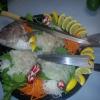

.thumb.jpg.86a685da52eb2f015ac52104c414040d.jpg)
